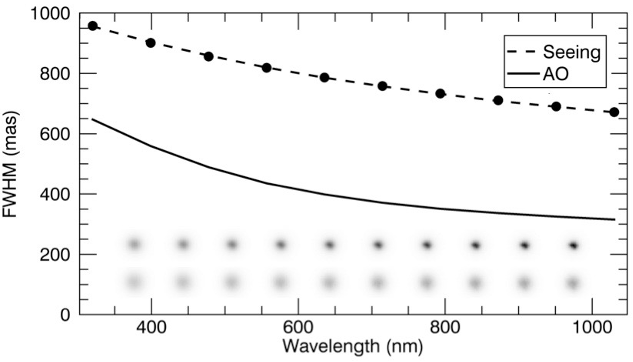SIGHT

System Description
Sharpening Images using Guidestars at the Hale Telescope (SIGHT) is a new approach to ground-based AO that will demonstrate panchromatic visible-to-infrared image improvement over the entire sky using an ultraviolet Rayleigh laser guide star and innovative polarization-encoding wavefront sensor. It is being built by the California Institute of Technology and is led by Rich Dekany (PI). JPL is a partner in the development of the instrument, which will become a facility installed at the 200-inch Hale telescope at Palomar Observatory, improving its optical/infrared spectroscopic sensitivity.SIGHT is a laser guide star (LGS) adaptive optics (AO) technology pathfinder. The project innovates by demonstrating for the first time a novel high-dynamic-range open-loop LGS Optical Differentiator Wavefront Sensor (ODWFS), cooling an AO science relay to -30C for thermal background reduction, automating LGS observations on a 5-meter telescope. SIGHT will achieve robust open-loop wavefront control, a control paradigm never before exploited for a general-purpose facility, but one enabling several new applications for medium to extremely large telescopes. Our approach improves over past AO systems by not requiring a large field of regard to be optically relayed, a feature historically required in order to maximize the serendipitous availability of natural guide stars (NGS). Unlike the vast majority of AO systems, the main goal of SIGHT is not diffraction limited imaging, but seeing improvement for the seeing limited instruments at Palomar Observatory. In good seeing, SIGHT will improve 0.6 arcsec Full Width Half Maximum (FWHM) images to an extraordinary 0.3 arcsec FWHM, while even in poor 2 arcsec seeing images will become a respectable ~1 arcsec FWHM, sufficient to save a night and deliver publishable science results.
Palomar Observatory is currently developing a new, highly-efficient medium-resolution single-object spectrograph to directly address the need for more capable transient object follow-up. The NextGeneration Palomar Spectrograph (NGPS) will in 2023 replace the Double Spectrograph (DBSP). NGPS provides simultaneous spectral coverage from the atmospheric cut-on at 320 nm to the silicon cut-off at ~ 1000 nm, with resolution R ~ 4600 and 2.7 pixels per resolution element sampling. In its own right, NGPS will be a powerful science engine. When fed by SIGHT, however, NGPS will have over 6x the observing speed advantage of DBSP, opening an entirely new discovery space, includinglow-latency studies of thousands of the most interesting transients discovered by the Rubin Observatory.

SIGHT FWHM improvement, as predicted by detailed wave-optics simulations. These realistic simulations incorporate SIGHT's open-loop LGS WFS control strategy, Robo-AO-based measured UV return photoflux, and measured vertical turbulence profile model for median seeing conditions assuming an outer scale of 25 meters. Close to a uniform factor of 2x FWHM improvement is obtained across the visible spectrum, with chromaticity only slightly larger than PSF variability naturally occurring in the atmosphere. Near-IR correction is expected to continue to maintain the ~270 mas FWHM, limited by residual uncorrected tip/tilt but well suited for our J-K cross-dispersed spectrograph, TripleSpec. The inset at bottom shows the PSF with (top) and without (bottom) seeing improved, as a function of wavelength.
